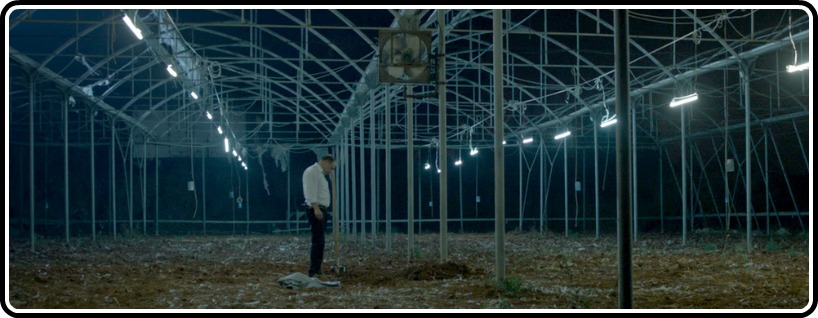
The only thing maniacs are afraid of is other maniacs.
It’s been a couple of years since I stumbled upon Aharon Keshales and Navot Papushado’s debut feature film Rabies at Fantastic Fest (review here), I was blown away by the atypical slasher film that came from Israel. It was mentioned as the first horror film that came from Israel, a country that has seen its fair share of atrocities, and was well made, with a dark and gore drenched sense of humor that made me fall in love with the film. It was even in my top 10 from that year. Fast forward to the 2013 Tribeca Film Festival and when I had heard news about their follow-up film playing here, I had to go see it. And I was not disappointed and it hasn’t left my mind since seeing it.
The film opens with one of more stellar opening sequences to be seen in quite some time. A dream-like game of hide and go seek, while the music (by Frank Ilfman) is playing louder and louder. Innocent enough, but being a horror fan one waits for something horrific to occur, especially when it’s the first few minutes of a film. But what Keshales and Papushado do is take us on this slow motion sequence, beautifully shot and seemingly light until the end where a little girl hiding has gone missing. We then focus on three specific men in the film, one being a determined investigator (a Clive Owen lookalike Lior Ashkenazi), the suspect who is becoming a victim (Rotem Keinan) and the father whose daughter was the last to be abducted and killed (Tzahi Grad). What occurs during the rest of the film is a hell of a feat.
Miki (Ashkenazi) has just been taken off the force by his superior because of a video that shows him dealing with the main suspect of the little girl murders Dror (Keinan) in a harsh way in an abandoned warehouse, using one of Detective Mackey’s from The Shield’s favorite ways of persuasion, which is a continuous barrage of phone book strikes to the face. He takes it upon himself as a civilian to continue his interrogation in order to find out where the girl’s heads are buried. While this is all going on, Dror is also suspended from his religious studies teaching gig because of parent intervention. And we see what toll it’s taken on the last victim’s father, Gidi (Grad), and the links that he will go to in order to enact his own revenge.
It’s a simple story, of almost Coen-esque proportions. Violence is used to shock but also for comic effect. At one moment you’re cringing and the next you can’t believe you’re laughing out loud at what is being shown on the screen. We know what’s going to happen, somehow Gidi is going to get Dror to the house he bought in the middle of nowhere (near Muslims, which isn’t safe according to many of the characters in the film) and we’re going to see torture. And we don’t want Dror to get hurt, because he seems to be a mild mannered and well meaning teacher who just so happens to be the center of attention during the investigation. But including Miki, the hotheaded detective who helps Gidi at first, because ultimately he wants the truth and knows in the pit of his stomach that Dror is the serial killer. As we move along, though, we don’t know what to believe and even Miki starts to doubt it as well and can’t continue to help Gidi with his torture.
The reason why the film works, while showing violence without batting an eye, also chooses to tell more than show. Which is much appreciated, especially after seeing a film like The Evil Dead in theaters and having waves of bloodletting and being ugly about it. In Big Bad Wolves, while there is bloodshed, there is a beheading, finger trauma, nail trauma and even a bit of flames to a chest, they know how to balance what we’re seeing and what we’re just hearing. Or panning away from right before we see the actual damage. Shooting from far away, especially with the victim in the park, is welcome and how we see the girl’s underwear around her ankles, we know what occurred without writing it out in front of us. It isn’t until later when Gidi starts to read out the killer’s methods of madness that we picture it in our head and feel sick to our stomach. It’s only fitting to him to torture Dror the same way that they think he did to his daughter and countless others.
Rabies was a fantastic introduction to Keshales and Papushado to the world of horror and film making in general. It was a sure hand they played but with Big Bad Wolves, they’ve shown such a leap into the next level that I can’t even imagine what they’re third film will be. Go into this film without seeing the trailer, like I did. The less you know, the better. With a more subtle idea and a realistic approach, they made a film more horrifying and hilarious at the same time. One of the best of Tribeca this year.



![Bergman Island (The Criterion Collection) [Blu-ray]](https://criterioncast.com/wp-content/uploads/2022/11/bergman-island-the-criterion-collection-blu-ray-400x496.jpg)
![This Is Not a Burial, It’s a Resurrection (The Criterion Collection) [Blu-ray]](https://criterioncast.com/wp-content/uploads/2022/11/this-is-not-a-burial-its-a-resurrection-the-criterion-collection-blu-ray-400x496.jpg)
![Lars von Trier's Europe Trilogy (The Criterion Collection) [The Element of Crime/Epidemic/Europa] [Blu-ray]](https://criterioncast.com/wp-content/uploads/2022/11/lars-von-triers-europe-trilogy-the-criterion-collection-the-element-of-400x496.jpg)
![Imitation of Life (The Criterion Collection) [Blu-ray]](https://criterioncast.com/wp-content/uploads/2022/11/imitation-of-life-the-criterion-collection-blu-ray-400x496.jpg)
![The Adventures of Baron Munchausen (The Criterion Collection) [4K UHD]](https://criterioncast.com/wp-content/uploads/2022/11/the-adventures-of-baron-munchausen-the-criterion-collection-4k-uhd-400x496.jpg)
![Cooley High [Criterion Collection] [Blu-ray] [1975]](https://criterioncast.com/wp-content/uploads/2022/11/cooley-high-criterion-collection-blu-ray-1975-400x496.jpg)